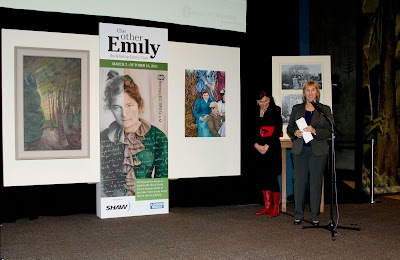
The Other Emily exhibition curator Kathryn Bridge and contemporary artist Manon Elder at the media event on January 17. The exhibition opens on March 2.
She is hailed as Canada’s greatest woman artist, but how well do we know the real Emily Carr?
A new Royal BC Museum feature exhibition set to open March 2, 2011 will have people re-examining the stubborn stereotypes that have come to characterize the iconic B.C. artist.
The Other Emily: Redefining Emily Carr draws on the Royal BC Museum’s vast Carr collection to mount the first-ever exhibition to explore the artist’s life before she became famous – from her formative teenage years to just before she emerges as a major force on the national art scene in 1927.
“This groundbreaking exhibition incorporates new historical research to reveal a side of Emily that has escaped major public examination, until now,” said Pauline Rafferty, CEO of the Royal BC Museum. “This exhibition demonstrates the power and importance of the Royal BC Museum’s archival records in stimulating new understanding of the past.”
The Other Emily tells a new story of the life of Emily Carr. The exhibition includes nineteen of Carr’s masterpieces, including one work recently acquired by the Royal BC Museum and on public display for the very first time.
In addition to the outstanding collection of original Carr paintings on display, visitors can admire more than a dozen rarely-seen sketches and drawings, view numerous manuscripts and handwritten letters, read personal diary accounts, examine archival photographs, and much more.

Royal BC Museum conservators recently found a hidden painting by Carr, shown here in an x-ray print, which she covered over to complete Bear Totem in 1937.
Eighteen contemporary paintings of Carr by artist Manon Elder are presented in counterpoint with the archival photographs that inspired them. Elder is well-known for her series of portraits of prominent living Canadian women.
The presentation is further enriched by tableaus of period clothing, objects, and artifacts that bring the historical photographs to life and provide further insights into this time in Carr’s development as an artist and person.
“The B.C. government is proud to support this exhibition on one of British Columbia’s most beloved artists and personalities,” said Stephanie Cadieux, Minister of Community, Sport and Cultural Development. “Manon Elder’s contribution to The Other Emily shows how valuable and inspirational the Royal BC Museum’s collections are today to artists and the public.”
According to exhibition curator Kathryn Bridge, we mostly get a clichéd one-sided portrayal of Carr – as a frumpily dressed, cranky, eccentric overwhelmed by pet animals, who was isolated, lonely, and unloved. It is a very fortunate fact, she says, that Carr left records of her thoughts, her struggles and her triumphs and it is through these archival records that we can give the full story.
“This exhibition is like pushing the reset button on our thinking about Emily Carr,” said Bridge. “By re-examining the archival history Carr left behind, this exhibition gives people the story behind her life to challenge our conventional thinking about who she was as an artist and a person.”
The 20 Carr paintings selected for the exhibition include some of her most-recognized works, such as Tanoo (1913) reflecting the post-impressionism style Carr was exposed to during her studies in France just a few years earlier, and Kispiox Village (1912) notable as the first Emily Carr painting donated to the people of British Columbia.
The exhibition also features several lesser-known works including two works completed while studying in France and Church of Our Lord (ca. 1895), recently acquired by the Royal BC Museum and never before on public display. It is one of Carr’s earliest known works and depicts the family’s church on Blanshard Street in Victoria. Rev. Edward Cridge and his family lived across the street from the Carr family, and Emily, her sisters and the Cridge daughters played together as children and remained friends throughout their lives.

